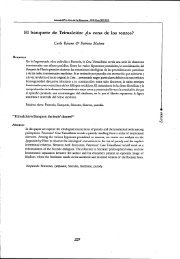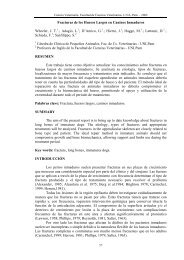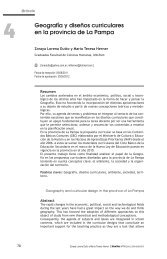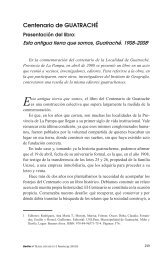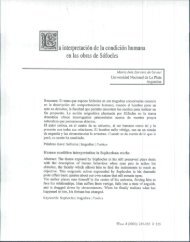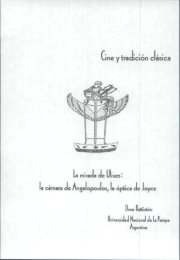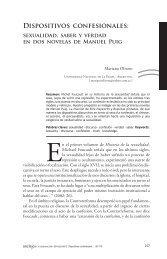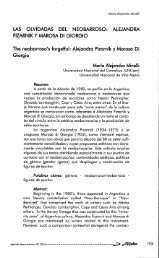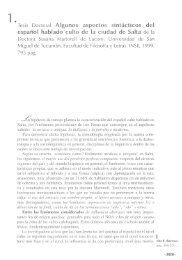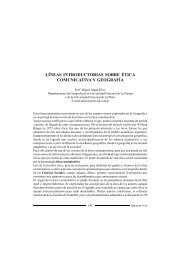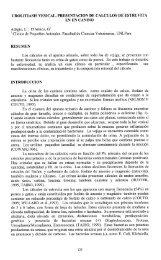Anuario 2008-2009.indb - BIBLIOTECA UNLPam
Anuario 2008-2009.indb - BIBLIOTECA UNLPam
Anuario 2008-2009.indb - BIBLIOTECA UNLPam
You also want an ePaper? Increase the reach of your titles
YUMPU automatically turns print PDFs into web optimized ePapers that Google loves.
Abstract<br />
<strong>Anuario</strong> Nº 8 - Fac. de Cs. Humanas - <strong>UNLPam</strong> (239-248)<br />
Trapped in Ireland: Violence and Irishness in McDonagh’s<br />
The Beauty Queen of Leenane<br />
Norma Alfonso<br />
Together with “A Skull in Connemara” and “The Lonesome West”, “The Beauty<br />
Queen of Leenane” (1996) is Martin McDonagh’s fi rst play in The Galway Trilogy. The<br />
world of the play shows an escalation of events which lead to an outburst of violence.<br />
McDonagh portrays, in a shocking way, the barbaric acts human beings are capable of<br />
when they feel that violence is the only tool they can employ in reaction to a miserable<br />
existence. Violence is also made evident in language since the characters engage in dialogues<br />
which not only tell a cruel story but also make directions for actions, character<br />
and space; they seem to be engaged in a never-ending vicious circle of brutality and<br />
despair. The purpose of this paper is to show how the characters’ inability to defi ne<br />
themselves in relation to their home and their country results into angry resentment at<br />
their own world, a place which seems to be both involved in and, at the same time, displaced<br />
from a globalized reality. This work is part of a research project on Irish literature<br />
that is being carried out at the Department of Foreign Languages, FCsHs, <strong>UNLPam</strong>.<br />
Keywords: in-yer-face theatre, violence, language, Irishness.<br />
Atrapados en Irlanda: violencia e identidad en The Beauty Queen of Leenane<br />
Resumen<br />
“The Beauty Queen of Leenane” (1996) es, junto con “A Skull in Connemara” y “The<br />
Lonesome West”, la primer obra de teatro de Martin McDonagh en The Galway Trilogy.<br />
La obra muestra una sucesión de eventos que resultan en un estallido de violencia.<br />
El autor describe de manera horrorosa los hechos barbáricos de los que los seres humanos<br />
son capaces cuando sienten que la violencia es la única herramienta a utilizar ante<br />
una existencia despreciable. La violencia se manifi esta también en el lenguaje ya que<br />
los personajes mantienen diálogos en los que no solo cuentan una historia cruel, sino<br />
que refi eren a acciones, personajes y espacios; ellos parecen atrapados en un interminable<br />
círculo vicioso de brutalidad y desesperanza. El objetivo de este trabajo es mostrar<br />
como la incapacidad de los personajes para defi nir su identidad en relación a su hogar<br />
y a su patria resulta en resentimiento hacia su propio mundo -lugar que parece estar<br />
inmerso en, pero a la vez desplazado de una realidad globalizada. Este trabajo es parte<br />
de un proyecto de investigación acerca de la literatura irlandesa que se lleva a cabo en el<br />
Departamento de Lenguas extranjeras, FCsHs, <strong>UNLPam</strong>.<br />
Palabras clave: in-yer-face theatre, violencia, lenguaje, identidad irlandesa.<br />
239<br />
Lenguas extranjeras
Alfonso, N. <strong>Anuario</strong> Nº 8 - Fac. de Cs. Humanas - <strong>UNLPam</strong> (239-248)<br />
Presos na Irlanda: violência e identidade em The Beauty Queen of Leenane<br />
Resumo<br />
“The Beauty Queen of Leenane” (1996) é, junto com “A Skull in Connemara” e “The<br />
Lonesome West”, a primeira obra de teatro de Martin McDonagh em The Galway Trilogy.<br />
A obra mostra uma sucessão de eventos que resultam em um estalido de violência.<br />
O autor descreve de maneira horrorosa os fatos bárbaros de que os seres humanos são<br />
capazes quando sentem que a violência é a única ferramenta ante uma existência depreciável.<br />
A violência se manifesta também na linguagem já que os personagens mantêm<br />
diálogos que não só contam uma historia cruel, mas que se referem a ações, personagens<br />
e espaços; eles parecem presos em um interminável círculo vicioso de brutalidade e desesperança.<br />
O objetivo deste trabalho é mostrar como a incapacidade dos personagens<br />
para defi nir sua identidade em relação a seu lar e a sua pátria resulta em ressentimento<br />
em seu próprio mundo, lugar que parece estar imerso, porém ao mesmo tempo deslocado,<br />
de uma realidade globalizada.<br />
Palavras chave: teatro in-yer-face, violência, linguagem, identidade irlandesa.<br />
240
Trapped in Ireland: Violence and Irishness in McDonagh’s The Beauty Queen of Leenane<br />
“The Beauty Queen of Leenane” (1996) is Martin McDonagh’s fi rst play, which he<br />
wrote after failing to have any success writing screenplays, radio plays or short stories. It<br />
is part of The Galway Trilogy together with “A Skull in Connemara” and “The Lonesome<br />
West”. All three plays are set in the small village of Leenane, County Galway and depict<br />
three villagers’ closely interwoven stories.<br />
Set in 1989, in the kitchen of a cottage in the west of Ireland, the play centres on<br />
the life of Maureen Folan, a forty-year-old spinster, and her brutal relationship with<br />
her clinging mother, seventy-year-old Mag. The highly demanding mother is a hypochondriac<br />
who abuses the daughter to a point where the daughter has become bitter<br />
and neurotic. Two sisters have escaped into marriage and family life, but Maureen, with<br />
a history of mental illness, is trapped in that cottage and in an excessively dependent<br />
dysfunctional relationship with her mother. In the course of the play, the Folan cottage<br />
is visited by the Ray and Pato Dooley brothers. An opportunity to leave this dead-end<br />
existence comes in the form of the oldest of these brothers, Pato, a former schoolmate<br />
of Maureen’s, who has been working in England for the past fi fteen years and is in love<br />
with her. Pato invites her to a family party but when she fi nds out that Mag hasn’t told<br />
her about the invitation, she makes Mag drink lumpy Complan and eat dry Kimberley<br />
biscuits as a kind of torture. After the party Maureen brings Pato back home; he calls<br />
her “The Beauty Queen of Leenane” and stays the night. The next morning Mag is<br />
shocked to fi nd him there, and tries to put him off by digging up a long-buried incident<br />
in Maureen’s past -a nervous breakdown and her ending up in a ‘nuthouse’. Soon<br />
afterwards, Pato, now a construction worker in London, writes to Maureen, asking her<br />
to accompany him to Boston with prospects of a better life. He sends the letter to Ray<br />
-his youngest brother- with instructions to hand it to Maureen, but the youth leaves it<br />
with Mag. She reads and burns it, but makes a verbal slip, and Maureen tortures her<br />
with boiling oil until she reveals the letter’s contents. Then, Maureen recalls how she<br />
saw Pato off at the station, promising to join him in America. Mag is rocking back and<br />
forth, when suddenly slumps forward to reveal a ‘red chunk of skull’. A few weeks later,<br />
Maureen, having got away with murder, plans to leave but Ray visits her and it emerges<br />
that her memory of seeing Pato off is a delusion. After telling her that his brother<br />
is engaged to another woman, Ray leaves with Maureen’s message to him: The Beauty<br />
Queen of Leenane says goodbye. Maureen then sinks into her mother’s rocking-chair.<br />
Mag’s stepping in has subverted their growing relationship, driving Maureen to insanity,<br />
and thus making her become an image of herself.<br />
The world of the play shows a series of events which lead to an outburst of violence.<br />
McDonagh portrays, in a shocking way, the barbaric acts human beings are capable of<br />
when they feel that violence is the only tool they can make use of in reaction to a miserable<br />
existence. Violence expresses real family hatreds and each character has her/his<br />
241<br />
Lenguas extranjeras
Alfonso, N. <strong>Anuario</strong> Nº 8 - Fac. de Cs. Humanas - <strong>UNLPam</strong> (239-248)<br />
own motivation to employ it. As Aleks Sierz expresses “the play’s violence is not just a<br />
comment on domestic life in a suffocating backwater; it also creates a world drenched<br />
in a nineties sensibility” (2000: 223). McDonagh depicts an exaggerated postmodern<br />
Ireland with a fragmented isolated society in a globalized world which leads people to<br />
violent reactions since they feel they can no longer control their lives. McDonagh’s style<br />
is characterized by a mix of savage irony and bizarre humour interspersed with an exuberant<br />
language drawn from the street-talks of English cities and the lyricism of rural<br />
Irish speech. The employment of Irish dialect, Gaelic patois, gives realism to the play.<br />
He draws on memories of Ireland based on recollections from summer vacations and on<br />
tales told by his Galway-born father to deal with Ireland’s uprootedness.<br />
Adhering to Wallis and Shepherd’s (1998) guide as to the appropriate reading of a<br />
play, readers should know it has to be read differently since “plays tell their own story<br />
without the aid of a narrator. The narration is done through the way the scenes succeed<br />
one another” (91); the change of scene being tied to a change in situation. A profi table<br />
way of approaching it is to become conscious that the words have not been designed<br />
to function as the words in a novel, but to become a performance. Readers should not<br />
only consider those chunks of dialogue which are spoken by the main characters; it is<br />
crucially signifi cant to read the bits in italics –the stage directions. Stage directions work<br />
in conjunction with dialogue to scrip what characters do or to explain dialogue. They<br />
provide “instructions regarding facial expressions, gesture and basic actions, costume,<br />
‘kinesics’ (moving about the stage), ‘proxemics’ (blocking), space and props” (8). They<br />
may also reveal what a character really means or is thinking about when he says something.<br />
In “The Beauty Queen of Leenane”, stage directions set the scenes, give information<br />
about facial expressions, describe actions performed by some characters and tell<br />
about the characters’ attitude when talking.<br />
Of equal importance, dialogue does more than simply tell a story; it creates “images,<br />
movement” and addresses “itself to the audience” (2). There are two lines of communication<br />
in theatre; one is between the characters and the other between the stage and the<br />
audience, the latter being a message by the writer. Information about characters is embedded<br />
in dialogues through which sociolect –a common way of speaking– establishes<br />
the character’s social origin. The audience easily imagine themselves in such a situation<br />
because “drama plugs into our [their] most basic desires, fears and wants” (40). Some<br />
plays, like “The Beauty Queen of Leenane”, are full of questionings or clashes and the<br />
management of dialogue works through a movement of holding back and releasing information<br />
about plot and characters. Besides, characters may possibly not refer to one<br />
another by name, but there is an act of naming and that does let readers know something.<br />
Maureen never calls Mag by her name but she refers to her as ‘oul’, ‘stupid’, ‘liar’,<br />
‘daft oul bitch’, just to mention some.<br />
242
Trapped in Ireland: Violence and Irishness in McDonagh’s The Beauty Queen of Leenane<br />
Ideology is another important aspect to consider when studying a play. Characters<br />
may speak from an ideological position and imagery and allusion may intensify discourse.<br />
The play assumes a certain amount of shared knowledge on the part of the audience<br />
as regards references, allusions, beliefs. The discursive frame of the play being analysed<br />
provides insight into the Irish people’s fragmented identity in a globalised world and<br />
their inability to recover their true self.<br />
Space and how dramatic texts script it are signifi cant in the theatre. In “The Beauty<br />
Queen of Leenane” the set is a replication of the world which is represented as a single<br />
room with distinct areas in which the action will be focused. There is a limited space<br />
from which the protagonist may fi nally break free or else the space may work to entrap<br />
the protagonist, as in Maureen’s case. Also, the characters’ movements in and out of the<br />
main space are an important part. The space which connects with the outside world -the<br />
front door- is used by Maureen, Pato and Ray. The other door, which leads to the hall is<br />
the one Mag always uses since she is never out of her home during the play.<br />
Playwrights may confer special signifi cance upon some objects which must be taken<br />
into account when reading a play. The writer uses every day objects such as Complan,<br />
Kimberleys, cooking oil and a heavy poker which make meaning when they become<br />
instruments of torture and murder. The stove poker, which is admired in an early scene<br />
and is an object which typically signifi es familial togetherness and warmth, is a theatrically<br />
highlighted future murder weapon. At one point, Maureen tells Pato that the<br />
only reason she buys the horrible Kimberleys is to torment her mother. Oil represents<br />
Maureen’s abuse of her mother both in the past and in the present. The threat of real<br />
violence is there from the beginning of the play, and some other objects carry hints of<br />
death: the photo of John and Robert Kennedy, both victims of political assassination<br />
and the embroidered tea towel which reads ‘May you be half an hour in heaven afore<br />
the Devil knows you’re dead’. The old woman who was murdered in Dublin, Maureen’s<br />
dream about her mother’s death, Ray’s comment about a fi lm in which everybody is<br />
always killing each other also contribute to the idea of anticipating death.<br />
“The Beauty Queen of Leenane” is one of those plays which, by means of theatrical<br />
innovation, represent a critique of modern life and shares features with a kind of drama<br />
called in-yer-face. But what is in-yer-face theatre?<br />
The widest defi nition is any drama that takes the audience by the scruff of the neck and<br />
shakes it until it gets the message. […] Questioning moral norms, it affronts the ruling<br />
ideas of what can or should be shown onstage; it also taps into more primitive feelings,<br />
smashing taboos, mentioning the forbidden, creating discomfort. Crucially, it tells us more<br />
about who we really are. […] The best in-yer-face theatre takes us on an emotional journey,<br />
getting under our skin. It is experiential, not speculative.<br />
The phrase ‘in-your-face’ is defi ned by the New Oxford English Dictionary (1998) as something<br />
‘blatantly aggressive or provocative, impossible to ignore or avoid’. The Collins<br />
English Dictionary (1998) adds the adjective ‘confrontational’. The phrase originated in<br />
243<br />
Lenguas extranjeras
Alfonso, N. <strong>Anuario</strong> Nº 8 - Fac. de Cs. Humanas - <strong>UNLPam</strong> (239-248)<br />
American sports journalism during the mid-seventies, and gradually seeped into more<br />
mainstream slang over the following decade. It implies that you are forced to see something<br />
close up, that your personal space has been invaded. It suggests the crossing of normal<br />
boundaries. In short, it describes perfectly the kind of theatre that puts audiences in just<br />
such a situation (Sierz 2000: 4).<br />
How can you tell a play is in-yer-face?<br />
* The language is usually fi lthy, characters talk about unmentionable subjects, take their<br />
clothes off, have sex, humiliate each another, experience unpleasant emotions, become<br />
suddenly violent. This kind of theatre is so powerful that it forces audiences to react:<br />
either they feel like fl eeing the building or they are suddenly convinced that it is the<br />
best thing they have ever seen. It inspires us to use superlatives, whether in praise or<br />
condemnation.<br />
* The use of shock is part of a search for deeper meaning, part of a rediscovery of theatrical<br />
possibility. Writers who provoke audiences or try to confront them are trying to<br />
push the boundaries off what is acceptable -they want to question current ideas of what<br />
is normal, what it means to be human, what is natural or what is real.<br />
* Provocation in performance my take the form of a new tone of voice being heard for<br />
the fi rst time, a question of sensibility or deliberate attacks on an audience’s prejudices.<br />
* This kind of theatre has an unusual power to trouble the audience emotionally. Most<br />
in-yer-face theatre challenges the distinctions we use to defi ne who we are: human/animal;<br />
clean /dirty; healthy/unhealthy; normal/abnormal; good/evil; true/ untrue; real/<br />
unreal; right/wrong; just/unjust; art/life. These binary oppositions are central to our<br />
worldview; questioning them can be unsettling.<br />
* It always forces us to look at ideas and feelings we would normally avoid because they<br />
are too painful, too frightening, too unpleasant or too acute. Taboos are broken not in<br />
individual seclusion but out in the open. Situations that are essentially private seem<br />
embarrassingly intimate onstage (5, 6).<br />
In the play under analysis, most of these characteristics can easily be traced. Violence<br />
is made evident in language, since the characters engage in dialogues which not only<br />
tell a cruel story but also make directions for action, character and space in a neverending<br />
vicious circle of brutality and despair. Examples of violence expressed through<br />
language abound. Maureen, who repeatedly scolds and chastises Mag, tells her rudely<br />
“you’re oul and you’re stupid and you don’t know what you’re talking about” (McDonagh<br />
1996:368). Maureen tells Pato, “Look at this. The radio left on too, the daft oul<br />
bitch” (382). Mag is worried about an old woman’s murder in Dublin and Maureen<br />
speaks her mind and says “that sounds exactly the type of fella I would like to meet, and<br />
then bring him home to meet you, if he likes murdering oul women” (368). She adds<br />
244
Trapped in Ireland: Violence and Irishness in McDonagh’s The Beauty Queen of Leenane<br />
that “for the pleasure of me [her] company he’d come. Killing you [Mag] it would just<br />
be a bonus for him.” Then she says that “if he clobbered you [Mag] with a big axe or<br />
something and took your [her] oul head off and spat in your [her] neck, I [she] wouldn’t<br />
mind at all, going fi rst” (369). Violence is used as a dramatic device since the writer’s<br />
desire to shock the audience is evidenced when Mag unexpectedly pitches forward and<br />
reveals her battered skull. Similarly, he creates suspense when Maureen approaches Ray<br />
from behind, carrying the poker in her hands.<br />
Theatre is a site of narration and the narratives are confessional self-representations.<br />
There are two monologues in the play which, in Nicolas Grene’s words, represent “a<br />
conservative continuation of the tradition by which the playwright and language have<br />
dominated Irish theatre to the exclusion of movement and visual effect” (in Kaleidoscopic<br />
views of Ireland 2003: 72). One of the monologues, which takes up the whole of<br />
scene fi ve, contains Pato’s letter to Maureen in which he expresses his wish that she goes<br />
with him to Boston given that his isolation between Ireland and England along with<br />
his desire for America become crucial to his identity and shape even his most intimate<br />
relationships. In reference to his feelings, he says “when it’s there I am, it’s here I wish I<br />
was, of course. Who wouldn’t? But when it’s here I am … it isn’t there I want to be, of<br />
course not. But I know it isn’t here I want to be either” (McDonagh 1996:385). There is<br />
another letter from Pato to his brother asking him to deliver his bunch of letters but giving<br />
special importance to Maureen’s letter which he wants his brother to “go over there<br />
the day you [he] get[s] this and put it in her hand” (400). The second monologue, scene<br />
eight, makes reference to Maureen’s encounter with Pato at the station as he was leaving<br />
the village. This is a crucial point in the story since at the beginning of the monologue<br />
Mag is sitting motionless in her chair, which is rocking by its own, and Maureen idles<br />
very slowly around the room with the stove poker in her hand. At the end of it, the chair<br />
has stopped moving, Mag falls heavily to the fl oor, dead, and Maureen contemplates her.<br />
She makes clear to everybody that her mother has tripped over a fence and fallen down<br />
the hill. Maureen has suffered a second breakdown.<br />
In his essay “Irish Culture in a Globalised World” (in Kaleidoscopic views of Ireland<br />
2003:80), Fintan O’Toole states that even though geographically and politically, Ireland<br />
may be a fi xed space, that space has been culturally open to invasion, immigration<br />
and infl uence. Ireland is a country redefi ning itself. The place is also part of the global<br />
village: Australian soap operas and American cop shows on the television, reference to<br />
Spiderman comics and Cadillacs, constant travelling to London and Boston, a picture<br />
of the Kennedy brothers. Yet, through its great number of emigrants, it has also poured<br />
out to other parts of the world such as Britain, the US, and Australia. But in the new<br />
context of Irish globalisation, there arises the question of authenticity and relationship<br />
to tradition. The characters in the play are painfully aware of their unstable national<br />
245<br />
Lenguas extranjeras
Alfonso, N. <strong>Anuario</strong> Nº 8 - Fac. de Cs. Humanas - <strong>UNLPam</strong> (239-248)<br />
identity, and their discussions of Irishness display disapproval of economic hardship and<br />
inferiority to the rest of the English-speaking world. The main theme in the play -the<br />
longing for rootedness- is revealed in the characters’ attitude who, even when aware of<br />
their impossibility to defi ne themselves in relation to home, region and nation, consistently<br />
return to them. As they look back and refl ect on what these sites once meant,<br />
their desires for a return become angry resentment against a world irrevocably changed<br />
by increasing forms of uneven globalisation. As Mag complains about not being able<br />
to understand an Irish singer, Maureen turns off the radio angrily since she thinks it is<br />
right that people speak Irish because they live in Ireland and adds that the crux of the<br />
matter is that “if it wasn’t for the English stealing our language, and our land, and our<br />
God-knows-what, wouldn’t it be we wouldn’t need to go over there begging for jobs and<br />
for handouts?” (McDonagh 1996: 367).<br />
The male characters project a second important theme in the play, that of the Irish<br />
emigrant mentality. As it has already been mentioned, Pato, a middle-aged man, has<br />
moved to London and then to Boston in search of better living conditions. Likewise,<br />
Ray, many years apart in age, is thinking of going to London or Manchester. Maureen<br />
and Pato’s talk about the sending-off party for their American friends and Pato’s imminent<br />
return to London to work illustrate the permanent migration of Irish people<br />
who sense they are caught between two lands and feel identifi ed with, but at the same<br />
time reject, both England and Ireland. Maureen says “that’s Ireland, anyways. There’s<br />
always someone leaving” (384). Even Maureen had her own experience cleaning offi ces<br />
in Leeds when she was twenty-fi ve, which ended up in her fi rst nervous breakdown and<br />
her stay in a nut-house in England.<br />
Though mostly devastating and tragic, the play is funny at times. McDonagh’s use of<br />
humour has the purpose of distracting the audience before a new cruel deed strikes them.<br />
Mag wants her Complan without lumps and watches Australian soap operas while waiting<br />
for the news. She pours the potty of wee away in the sink every morning but when<br />
Maureen asks Pato to smell the sink, Mag says “nothing to do with it, sinks have!” (392).<br />
Some jokes involve social comment: the priest is 35 and he fi nds himself adopting the less<br />
desirable qualities of his parishioners: exasperated outbursts of violence. Ray tells Mag that<br />
while young priests seldom use violence, “it is usually only the older priests go punching<br />
you in the head. I don’t know why. I suppose it’s the way they were brought up” (372).<br />
Violence is also made evident in Maureen’s dreams. In her struggle to break free from<br />
her mother’s demands and from her monotonous life, Maureen dreams “of anything!<br />
Of anything. Other than this” (378). Readers can realize the intensity of Maureen’s<br />
frustration in scene two when she tells Mag about a “day-dream […] something happy<br />
to be thinking of when I’m [she’s] scraping the skitter out of them hens” (379) in which<br />
she is standing beside Mag’s coffi n with “a fella beside [her] there, comforting [her], the<br />
246
Trapped in Ireland: Violence and Irishness in McDonagh’s The Beauty Queen of Leenane<br />
smell of aftershave off him, his arm around me [her] waist” (379). In scenes three and<br />
four Maureen’s dreams are on the verge of becoming true with the appearance of Pato<br />
Dooley. Pato represents the possibility of escape -possibility which is quickly frustrated<br />
when Mag reveals to him that Maureen has scolded her hand and that, due to a nervous<br />
breakdown fi fteen years before, spent some time at a nuthouse. Twice in scene four Mag<br />
asks Maureen to be “more in your [her] line” (393, 397). After Mag’s revelations, Maureen<br />
asks Pato to leave and the fi rst act of the play ends.<br />
What is striking all through the play is the utter lack of moral values. In the town of<br />
Leenane, no one is easily shocked. Casual discussions of violence fi ll the play -the characters<br />
are more upset by insignifi cant complaints than by news of manslaughter or murder.<br />
They seem to live by their own individual moral codes and violence usually erupts when<br />
those codes collide. Maureen is not punished for her mother’s murder; her acts escape<br />
any clear moral judgement. From the opening of the play, readers can witness Mag’s<br />
unreasonable demands and incessant complaints. Thus, readers identify with Maureen<br />
who appears as the voice of truth and, by the time they know about Mag’s murder -the<br />
most repulsive act which shows absence of familial rootedness, readers cannot decide if<br />
they should be horrifi ed by this act of matricide given that Maureen looks as if she has<br />
been driven to murder. Then, Maureen exhibits some of her mother’s personality traits<br />
-becoming confused and disoriented during an exchange with Ray, forgetting Ray’s<br />
name and calling him Pato. At the beginning of the play, Mag is waiting for her absent<br />
daughters’ radio request for her birthday but it is just at the end, when Maureen takes<br />
Mag’s place, that the request can be heard.<br />
There is a moment of revelation at the end of scene eight where the dead Mag topples<br />
out of her rocking-chair; the uselessness of the murder is pointed up in the last scene when<br />
the readers conclude Mag’s murder doesn’t free her, but imprisons her more. Maureen has<br />
already taken her mother’s place in that same chair and, as Ray says, she has become the<br />
exact fecking image (424) of her mother. Yet, the play supports a need to destroy the mother<br />
as it stands for the motherland with all its mythology of the rural west: with a mother like<br />
Mag, and with a home like Leenane, matricide is seen as wholly justifi ed.<br />
Writing from within that interstitial space -Ireland and England- McDonagh traces<br />
the issue of national identity in a globalised context and highlights the value of ethnicity<br />
for a community that feels their depletion is due to their Irish origin. By means of a<br />
shocking form of art, the writer gives a convincing portrait of wild rural Ireland, making<br />
people aware of the reality of violence in parts of the country. Given the collapse of<br />
traditional spaces –home, region, and nation– and identities –mother, daughter, Irish<br />
citizen, emigrant– the characters share unconventional relationships characterized by<br />
isolation, betrayal and brutality. In their inability to defi ne themselves, these unstable<br />
identities are always in a permanent process of becoming.<br />
247<br />
Lenguas extranjeras
Alfonso, N. <strong>Anuario</strong> Nº 8 - Fac. de Cs. Humanas - <strong>UNLPam</strong> (239-248)<br />
Works cited<br />
Grene, N. (2003). The Spaces of Irish Drama. Kaleidoscopic views of Ireland<br />
McDonagh, M. (1998). The Beauty Queen of Leenane. En The Beauty Queen of Leenane and Other Plays.<br />
Vintage: New York.<br />
Mutran, M. H. & Izarra, L. P. Z. (Ed.). Humanitas. Brazil: FFLCH/USP.<br />
O’Toole, F. (2003). Irish Culture in a Globalized World. Kaleidoscopic views of Ireland.<br />
Sierz, A. (2000). In-Yer-Face Theatre–British Drama Today. England: Faber & Faber Limited.<br />
Wallis, M. & Shepherd, S. (1998). Studying Plays. Great Britain: Arnold.<br />
248



